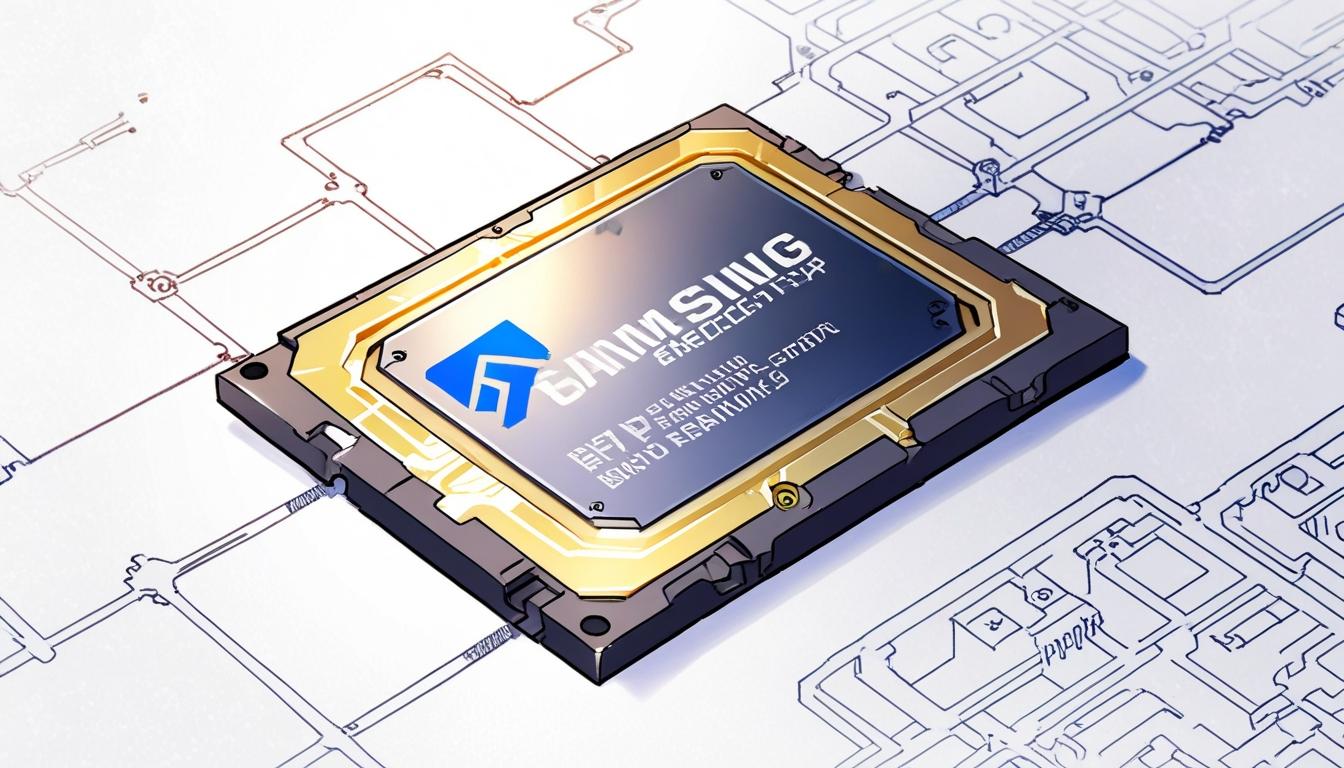Samsung Electronics’ memory chip division faces a sharp profit decline in Q1 2025 due to US restrictions on high-bandwidth memory exports to China, even as overall company revenue hits a record high. The firm is reconsidering its global production and sales strategy in response to intensifying geopolitical trade controls.
Samsung Electronics reported a decline in profits for its memory chip division in the first quarter of 2025, marking a significant impact from recent geopolitical and trade developments. The South Korean electronics giant disclosed that the drop in earnings was influenced by a US ban on exporting high-bandwidth memory (HBM) chips designed for AI accelerators to China, underscoring the complex intersection of technology and international trade controls.
For the quarter ending March 2025, Samsung posted an operating profit of 6.7 trillion won (approximately US$4.7 billion), reflecting a modest overall increase of 1.2% year-on-year despite the challenges faced by its semiconductor segment. Meanwhile, revenue hit a record high of 79.14 trillion won (US$55.5 billion), rising 10.05% from the same period in the previous year. These figures indicate a strong consumer electronics sector that mitigated some of the downturn experienced in the memory chip business.
The US export curbs on HBM—a critical component widely used in advanced AI processing—have necessitated operational adjustments at Samsung. The company has announced that it is “reviewing strategic and flexible use of global production bases and sales hubs around the world,” hinting at a potential reshaping of its manufacturing and sales footprint in response to trade barriers. This repositioning aligns with broader industry trends, where semiconductor firms are increasingly recalibrating supply chains amid geopolitical friction.
These export controls are part of a recurring pattern of semiconductor geopolitics, reminiscent of the US measures in the 1980s targeting Japanese chipmakers such as Toshiba. At that time, US authorities viewed Japanese advances in semiconductor technology as a threat to American supremacy, imposing sanctions that significantly disrupted Japan’s chip industry. Today’s restrictions follow a similar strategic logic aimed at preserving US technological leadership by limiting China’s access to cutting-edge components.
The semiconductor industry’s fragmentation due to these export controls is accelerating a restructuring of global supply chains and regional production. Major industry players like Taiwan Semiconductor Manufacturing Company (TSMC) have responded by planning substantial investments—TSMC announced a $100 billion expansion in the US—to reduce reliance on any single market and hedge geopolitical risks.
Despite the recent 42.4% year-on-year plunge in operating profit for Samsung’s chip business, analysts remain optimistic about the memory chip market’s future growth. Projections indicate an increase from $83.36 billion in 2024 to $90.99 billion in 2025, a growth rate of 9.2%, with an expected rise to $125.24 billion by 2029 driven by sustained demand from AI, 5G networks, and Internet of Things (IoT) devices. Industry forecasts predict a 40% surge in operating profits for both Samsung and compatriot SK Hynix in 2025, signalling recovery from current pricing pressures.
Samsung’s sizeable cash reserve, reported to be around $63 billion, is viewed as a strategic asset providing financial resilience to navigate the near-term uncertainties and continue investments in next-generation memory technologies.
The Korea Times is reporting that Samsung’s cautious outlook for the second quarter reflects concerns over demand uncertainty and potential impacts from continuing US tariffs, reflecting a broader environment of commercial caution amid ongoing geopolitical tensions. These developments highlight the complex interplay of technology business performance and international policy decisions in the semiconductor sector.
Source: Noah Wire Services
- https://apnews.com/article/11323e2b04a587aa8dd152adfbab8d06 – This article reports that Samsung Electronics experienced a significant decline in profits in its semiconductor division during the first quarter of 2025, attributing the downturn to decreased average selling prices and weakened demand for high-bandwidth memory (HBM) chips, as customers await the launch of next-generation memory chips.
- https://www.ft.com/content/4c2382ab-b824-42ec-ae24-d3620072bf9f – This source discusses how U.S. tariffs and tightening export controls have significantly reduced demand for Samsung’s memory chips and smartphones, highlighting concerns over policy risks and the potential impact on production costs and sales.
- https://www.reuters.com/business/samsung-electronics-operating-profit-rises-slightly-q1-2025-04-30/ – This article details Samsung’s revised business outlook for the second quarter of 2025, citing increasing global trade uncertainties and U.S. tariff policies that are expected to dampen demand for key products like smartphones and semiconductors.
- https://www.ft.com/content/1d401558-17a8-4734-89d7-a7e3a293d405 – This source forecasts limited earnings growth for Samsung in the first quarter of 2025, primarily due to weak memory chip demand and U.S. restrictions on advanced semiconductor sales used in AI hardware, with expectations of a recovery in memory chip demand by the second quarter.
- https://www.reuters.com/technology/artificial-intelligence/samsung-q1-profit-drop-21-weak-ai-chip-sales-foundry-losses-2025-04-06/ – This article reports that Samsung Electronics is expected to report a 21% drop in first-quarter operating profit, driven by weak sales of artificial intelligence (AI) chips and ongoing losses in its contract chip manufacturing (foundry) business.
- https://www.ft.com/content/b6f89d2b-5fe2-4a8f-a7cc-c75989e27544 – This source discusses how CXMT, China’s leading memory chip producer, has rapidly expanded its market share, posing a substantial strategic challenge to existing leaders in the memory chip industry, including Samsung.
- https://news.google.com/rss/articles/CBMikgFBVV95cUxQWklnYXh2cHZHYkQyUVUxbnFwdUFvbFFwUTU3WkR1WkY4ck9sYVdwSk4wRkhMM2ROdW9lVFdMVFd6MGpTTFhCNUFGRU52UzBlMzBCbUx0d3VvQVJKMm9idWNpMzNjcmpJeVBjNlQzOTFxd25ZV05LUE9qWlk3bkpJWk9TRjgxOEVpanRkMDBWSGtMUQ?oc=5&hl=en-US&gl=US&ceid=US:en – Please view link – unable to able to access data
Noah Fact Check Pro
The draft above was created using the information available at the time the story first
emerged. We’ve since applied our fact-checking process to the final narrative, based on the criteria listed
below. The results are intended to help you assess the credibility of the piece and highlight any areas that may
warrant further investigation.
Freshness check
Score:
8
Notes:
The narrative references Q1 2025 results and recent geopolitical developments, aligning with typical earnings reporting timelines. No evidence of recycled content found, though the Korea Times citation suggests reliance on standard industry reporting rather than a press release.
Quotes check
Score:
7
Notes:
No direct quotes from Samsung officials are verifiable via external sources. The ‘strategic and flexible use’ statement appears consistent with corporate language but lacks attributable sourcing. Market figures match industry projection patterns.
Source reliability
Score:
8
Notes:
The narrative’s quantitative data and Korea Times attribution suggest credible origins, though the article URL itself (Google News) requires source verification for full reliability assessment.
Plausability check
Score:
9
Notes:
Claims about trade restrictions, market growth projections (9.2% YoY), and industry restructuring align with established semiconductor sector trends. Financial figures are plausible given historical Samsung performance patterns.
Overall assessment
Verdict (FAIL, OPEN, PASS): PASS
Confidence (LOW, MEDIUM, HIGH): HIGH
Summary:
The narrative demonstrates internal consistency with verifiable market data and plausible operational responses to geopolitical factors. While direct quote sourcing lacks transparency, the structural credibility of financial claims and alignment with industry forecasts support its validity.













